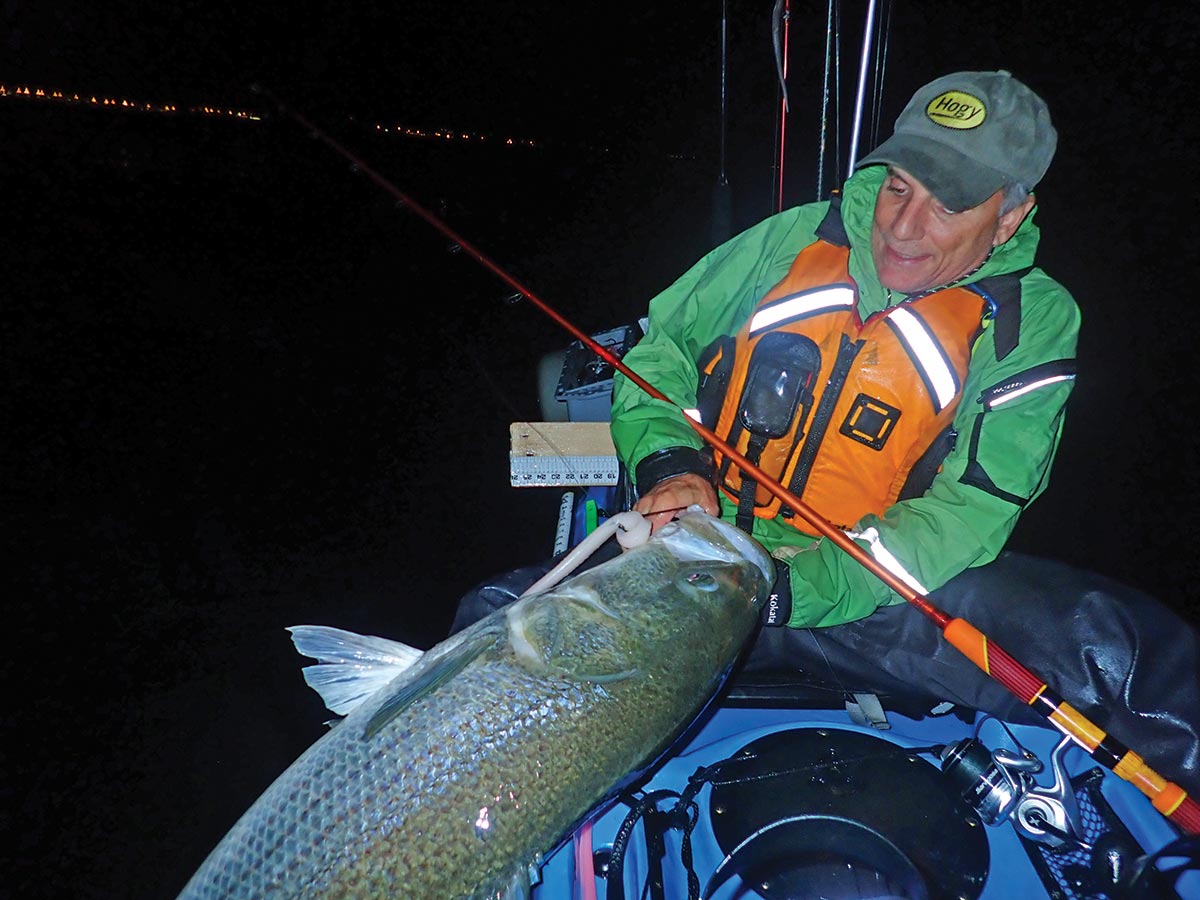
From shallow rockpiles to mid-depth reefs, slender rubber baits are fast becoming the go-to choice of striped bass sharpies.
It was three days before the new moon and the tide had just began to flood. The bite slowed down considerably through the slack, but the ebb had been quite productive as we boated seven fish from 17 to 38 pounds and missed several others. The captain positioned the boat about 100 yards above where the rip line could already be seen forming on the surface of the otherwise glass-calm water on this moonless night. In years past I’d be wrestling the largest snake in the bucket at this stage of the game, fighting to embed a 7/0 circle hook into its mouth while doing my best to prevent a dreaded eel ball, but not tonight. In place of a heavy conventional rod and three-way rig I was using what I’d normally have been using if targeting shallow-water stripers: a 7-foot spinning rod, 4000-class reel and soft plastic “worm” pinned on a jig head. The only real differences from that inshore set-up to what I used this night was in the weight of the jig head and the length of the rubber, both scaled up to meet the requirements of the conditions and the quarry.
With the engine in neutral I pitched the rubber worm slightly down-current, allowed line to flow off the reel until making first contact with the bottom and then flipped the bail. On the second light pop of the rod I felt a hard take and set up on another large striped bass; we were back on the bite!
Fishing rubber baits for striped bass is nothing new. Heck, the late Tim Coleman started using true freshwater worms on small jigheads with great success on large striped bass many years ago, but it has been rather slow to catch on with the masses. Fortunately for us today, there has been a recent surge in popularity of this tactic as many fishermen have begun passing on a bucket of eels and instead pack a variety of 9- to 13-or-more-inch soft plastics and a selection of jig heads in its place. What’s even better is that many are reporting similar if not better success at times on striped bass well into the 50-pound class than they had experienced with the real deal.
While this tactic is not going to work everywhere, it has its spots where it does excel. That 100-foot deep channel with a 2-plus-knot current is probably better suited for more traditional methods like 3-wayed eels or diamond jigs, but places where striped bass frequent in the early summer months like the rips off Montauk or Block Island are perfect. So too are the smaller, lesser-fished rips and rockpiles up and down the coast where small boats and kayaks excel.
Tackling the Gear
You can go spinning or conventional here, depending on your personal preferences, and I can’t really say that either one is all that much better than the other as they each have their pros and cons. The one constant that I’d say carries over between the two is the use of braided line. Twenty-pound braid is fine if you plan to fish more open water without snags and other boats nearby, but I’d opt for 30- or even 40-pound braid for most locations. If you plan to fish really gnarly reefs or rockpiles, then by all means step it up to 50-pound braid, but once you start getting that heavy it becomes more difficult to fish the lighter jig heads and swimbait hooks that can be used.
Rod choice, too, can be of personal preference. A rod of 7 feet or so is a good choice but you can go longer or shorter if your boat or kayak allows. You want a somewhat light tip to properly feel bottom with light jigs or weightless presentations, but you still need the backbone to stop a heavy striped bass once hooked. The biggest downfall of light-tackle enthusiasts these days comes in the form of striped bass release mortality caused by unnecessarily over-stressed fish—a subject of which has been garnering tons of press these days since the recent updated stock assessment—so I recommend erring on the side of a somewhat stouter rod when you can.
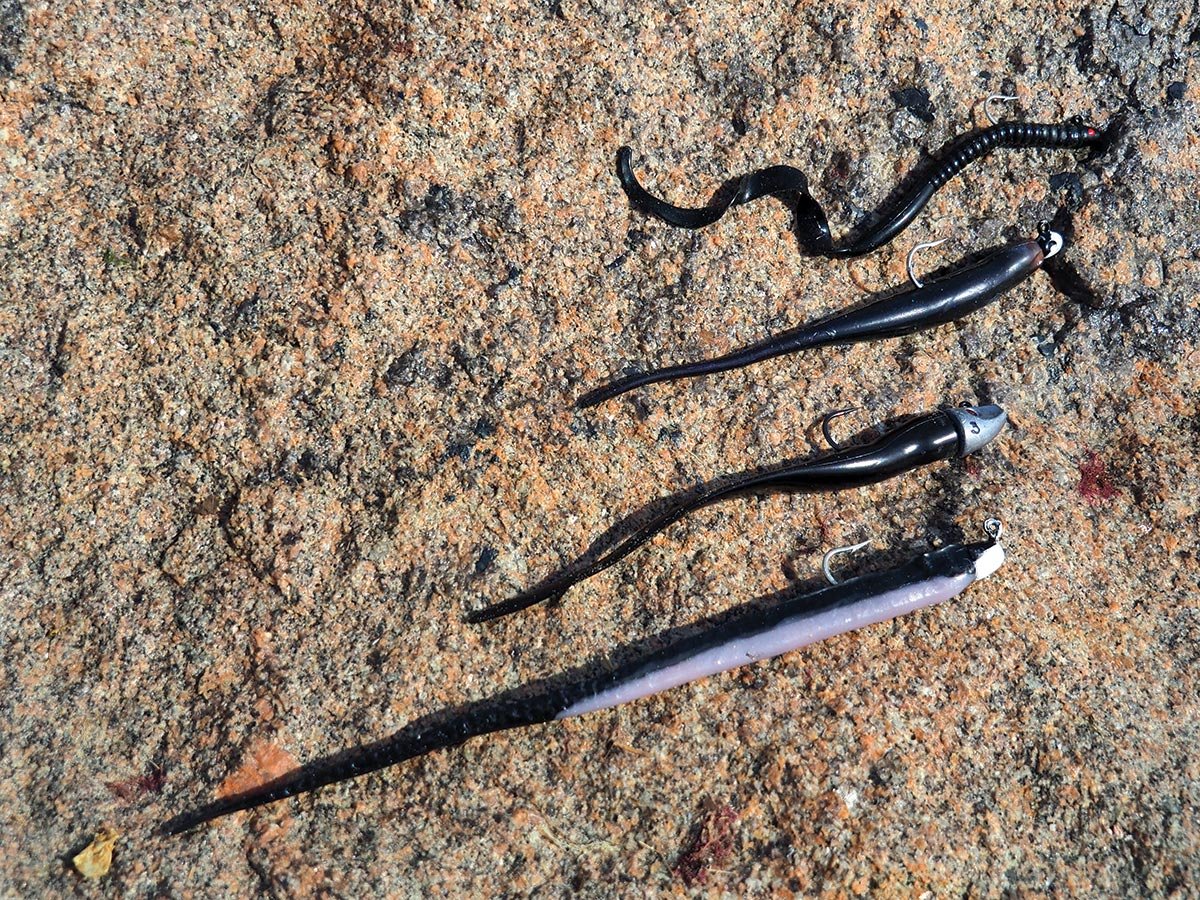
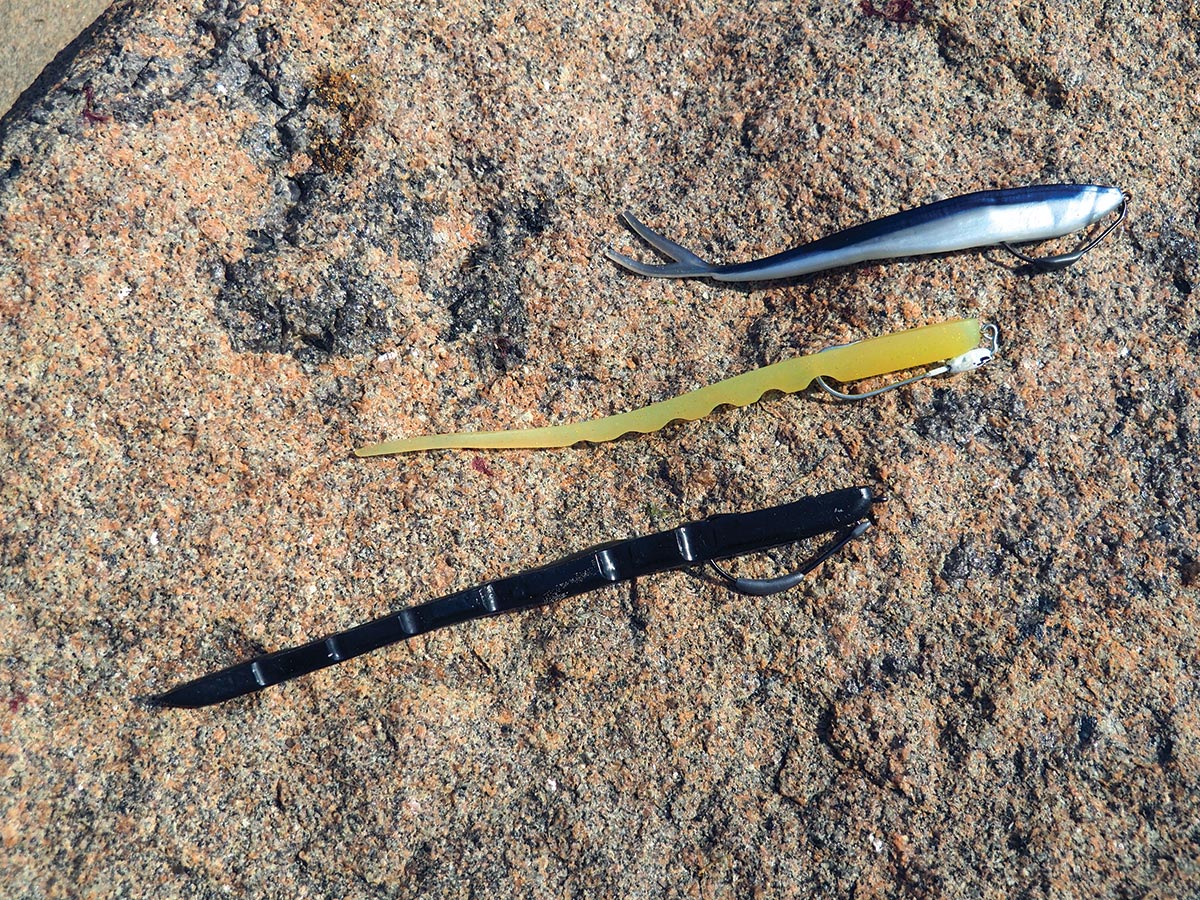
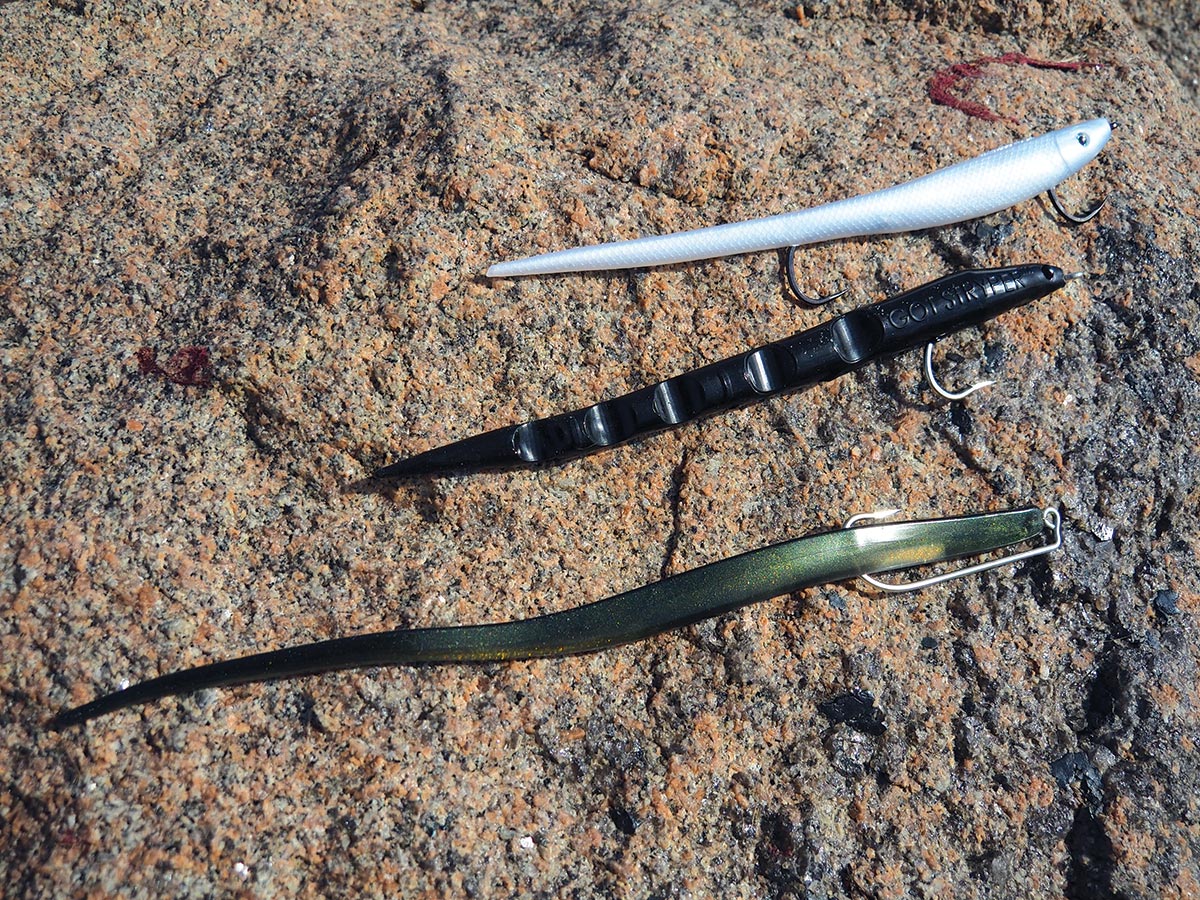
For a leader I generally opt for 50-pound mono on all but the clearest and brightest of nights; in those scenarios I drop down to 40. By day 40 is a good starting point but be prepared to go down to 30 and even 20 at times when the water is extra clear, and the fish are heavily-pressured. This might be a scenario where fluorocarbon has an edge over monofilament between its improved abrasion-resistance and “invisibility” benefits, especially in those lighter lines. However, to counter this idea, I will remind you that we caught plenty of bass before the introduction of fluorocarbon so don’t blindly buy into its superiority.
Tying direct is a matter of personal choice. I find it extremely hard to believe that a fish is going to pass on your offering and perceive it to be unnatural just because a snap is attached to the front of the jig when an inch or two behind the snap is an obviously-unnatural hook protruding from the rubber, but to each his own. You can make an argument for traditional duo-lock and even cross-lock snaps having a tendency to open up during a battle, but this is all but eliminated by the use of today’s modern “paper clip” snaps like those made by Tactical Angler, Spro and the likes.
The Baits
There are lots of options here, and don’t be afraid to use a truly massive bait. It is quite common to use live eels pushing 20 inches, so why the hesitation to fish 12- or 13-inch soft plastics pinned on 1/2-ounce heads? A striped bass of even moderate size has no problem getting the entire bait in its mouth in a single slurp, so don’t be afraid that there is too much rubber sitting behind the bend of the hook.
First up is the option of making your own. If you flip back to the March 2019 issue of The Fisherman Magazine, you’ll see an article on pouring your own soft plastics by Tommy Fucini. If you have some free time and the space to do it, pouring your own soft plastics is a rewarding hobby. This option gives you the ability to come up with a custom size, shape and color for your specific needs, and similar to building rods or spinning wooden lures, there is a high level of satisfaction that comes from fooling a fish on your own creations.
If pouring your own is not an option, then fear not as there is an ever-growing market of large soft plastics readily available at your local tackle shop. Baits from the likes of RonZ, Al Gags, Got Stryper, Lunker City, Hogy, Gravity Tackle, MegaStrike, Z-Man and others fit the bill. While these baits come in a wide variety of colors, I find myself falling back on the standards of black, white or black over white most of the time.
Rigging Options
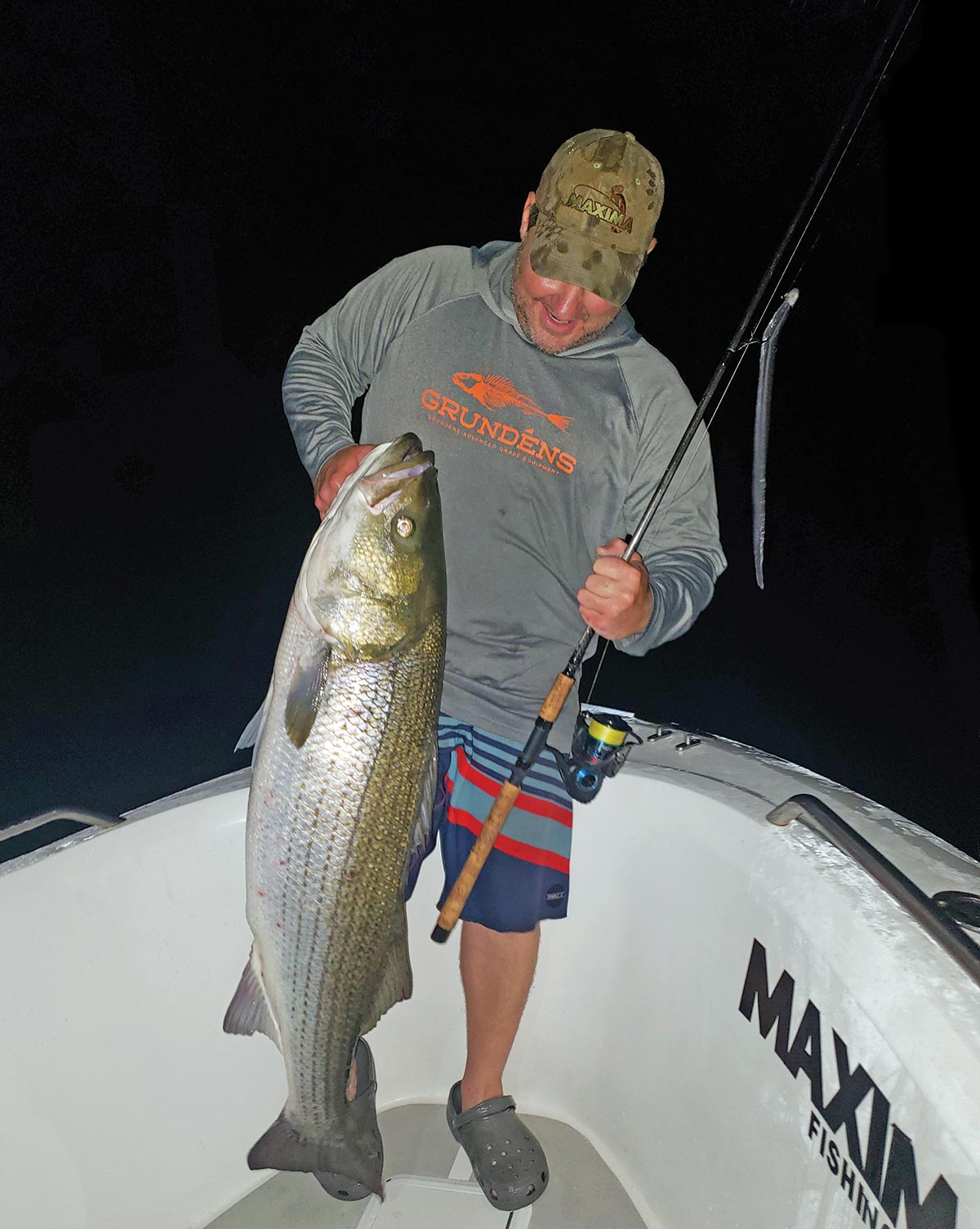
There is nothing fancy here, but how you rig those big soft plastics goes a long way to how and where they can be fished. For instance, a weightless swimbait hook isn’t the best choice to fish the bottom in 50 feet of water, and likewise a 2-ounce jighead pitched into a rockpile in 6 feet of water will only serve to keep your local tackle shop in business.
Starting shallow, a weightless single hook or 2-hook rig is good for the slowest stage of the tide and around slack. You can rig these baits on large swimbait hooks like the Owner Beast, Trokar swimbait hook or the Z-Man TT Lures ChinLockZ SWS Swimbait hook when fishing shallow. These hooks come in both weightless and weighted variations and in hook sizes up to 12/0 so you can adjust the hook based on water depth. Both Hogy and Lunker City have hooks specifically designed for their baits, too. For those of you out there looking to craft your own rigs, there are options as well. For years I used a simple Mustad O`Shaughnessy hook impaled in the head of my soft plastics for shallow water, and it never failed me. I recently began adding an Owner Centering Pin Spring to a 9/0 Mustad jig hook and really like the results so far.
When working deeper rips you will need to add some additional weight, and a standard jig head fits the bill here. I really like the JoeBaggs Tackle SPJ heads, but there are options from Owner, Uncle Josh, Savage, RonZ, Gamakatsu, Magic Tail Bucktails, Mustad and others, just to name a few. Weight-wise you can get away with 1/2-ounce heads when fishing shallow and around slack, but as the tide gets going you will need to increase the weight to as much as 3 or perhaps 4 ounces. If the situation requires more weight then much of the benefit of this application is lost and it’s probably better to use more traditional methods.
So with the next new moon fast-approaching on July 2, and large striped bass settling into their summer haunts, consider adding some large rubber worms to your arsenal either in place of or to compliment that bucket of eels. I am sure you’ll be happily surprised with the results and you can add another tool to your bag of tricks.




